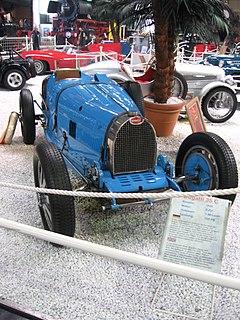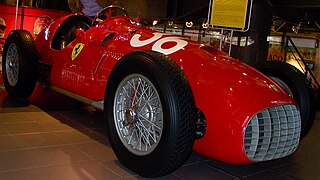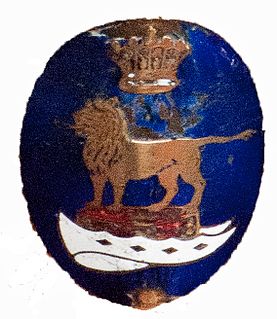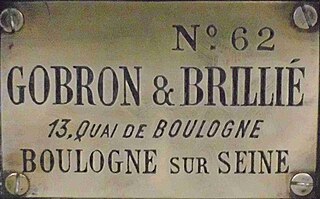
The Cooper Car Company is a car manufacturer founded in December 1947 by Charles Cooper and his son John Cooper. Together with John's boyhood friend, Eric Brandon, they began by building racing cars in Charles's small garage in Surbiton, Surrey, England, in 1946. Through the 1950s and early 1960s they reached motor racing's highest levels as their rear-engined, single-seat cars altered the face of Formula One and the Indianapolis 500, and their Mini Cooper dominated rally racing. Due in part to Cooper's legacy, Great Britain remains the home of a thriving racing industry, and the Cooper name lives on in the Cooper versions of the Mini production cars that are still built in England, but are now owned and marketed by BMW.

Hillman is a British automobile marque created by the Hillman Motor Car Company, founded in 1907. The company was based in Ryton-on-Dunsmore, near Coventry, England. Before 1907 the company had built bicycles. Newly under the control of the Rootes brothers, the Hillman company was acquired by Humber in 1928. Hillman was used as the small car marque of Humber Limited from 1931, but until 1937 Hillman did continue to sell large cars. The Rootes brothers reached a sixty per cent holding of Humber in 1932 which they retained until 1967, when Chrysler bought Rootes and bought out the other forty per cent of shareholders in Humber. The marque continued to be used under Chrysler until 1976.

NSU Motorenwerke AG, or NSU, was a German manufacturer of automobiles, motorcycles and pedal cycles, founded in 1873. Acquired by Volkswagen Group in 1969, VW merged NSU with Auto Union, creating Audi NSU Auto Union AG, ultimately Audi. The name NSU originated as an abbreviation of "Neckarsulm", the city where NSU was located.

Argyll was a Scottish motor car marque manufactured from 1899 to 1932, and again from 1976 to around 1990.

L'Aster, Aster, Ateliers de Construction Mecanique l'Aster, was a French manufacturer of automobiles and the leading supplier of engines to other manufacturers from the late 1890s until circa 1910/12. Although primarily known as an engine mass manufacturer the company also produced chassis for coach-works and a complete range of components.

Delage was a French luxury automobile and racecar company founded in 1905 by Louis Delage in Levallois-Perret near Paris; it was acquired by Delahaye in 1935 and ceased operation in 1953.
Stebro was a Canadian constructor of Formula Junior racing cars. The team also competed in one Formula One race, the 1963 United States Grand Prix, where their one car finished in seventh place.
Bellasi is a Swiss-Italian motorsport company specialized in manufacturing composite parts for racing cars. From 1970 to 1971 it was a Formula One constructor. They participated in six grands prix, entering a total of six cars.

The Type 13 was the first true Bugatti car. Production of the Type 13 and later Types 15, 17, 22, and 23, began with the company's founding in 1910 and lasted through 1920 with 435 examples produced. Most road cars used an eight-valve engine, though five Type 13 racers had 16-valve heads, some of the first ever produced. The road cars became known as pur-sang ("thoroughbred") in keeping with Ettore Bugatti's feelings for his designs.

The Type 35 was the most successful of the Bugatti racing models. Its version of the Bugatti arch-shaped radiator that had evolved from the more architectural one of the Bugatti Type 13 Brescia, was to become the one that the marque is most known for though even in the ranks of the various Type 35s there were variations on the theme.

After finding only modest success with the supercharged 125 F1 car in Formula One, Ferrari decided to switch for 1950 to the naturally aspirated 4.5-litre formula for the series. Calling in Aurelio Lampredi to replace Gioacchino Colombo as technical director, Enzo Ferrari directed that the company work in stages to grow and develop an entirely new large-displacement V12 engine for racing.

The Star Motor Company was a British car and commercial vehicle maker based in Wolverhampton and active from 1898 to 1932. At its peak Star was the UK's sixth largest car manufacturer and produced around 1000 cars a year.

Straker-Squire was a British automobile manufacturer based in Bristol, and later Edmonton in North London.

Voitures automobiles Decauville was a French automobile maker, a subsidiary of Société Decauville, a company already famous for producing locomotives, located at Petit-Bourg, near Corbeil.
The Advance Motor Manufacturing Company was a British motorcycle and engine manufacturer established in 1905. As well as supplying aircraft engines to the pioneering monoplane developers, Advance engines were also used by Captain Robert Scott to power Antarctic snow sleds. After the end of the Second World War the company was sold to Sheepbridge Engineering and became a motor supplies organisation.
The Marlborough was a make of car sold on the British market between 1906 and 1926. For most of its life the cars were made by Malicet et Blin in France, but after World War I they were partially assembled (finished) in London and an increasing number of British parts used.

Clément-Talbot Limited was a British motor vehicle manufacturer with its works in Ladbroke Grove, North Kensington, London, founded in 1902. Rootes renamed it Sunbeam-Talbot Limited in 1938.

The Austin 40 hp is a 4-cylinder motor car launched at the Olympia Motor Show in November 1907. Manufactured by Austin at Longbridge, Northfield, Birmingham, it was the first variant from Austin's initial plans for a two model range of a 15 hp —which they had dropped—and a 25 hp car.

Gobron-Brillié was an early French automobile manufactured from 1898 to 1930. The original company, Societé des Moteurs Gobron-Brillié, was founded by the French engineer, Eugène Brillié, and industrialist, Gustave Gobron, at 13, quai de Boulougne, Boulougne-sur-Seine, near Paris, in 1898.

The Fiat 130 HP is a Grand Prix racing car made by Fiat in 1907 to a design by Giovanni Enrico. Built solely for Grand Prix motor racing, the Fiat 130 HP included new design features, such as overhead valves and hemispherical compression chambers.


















